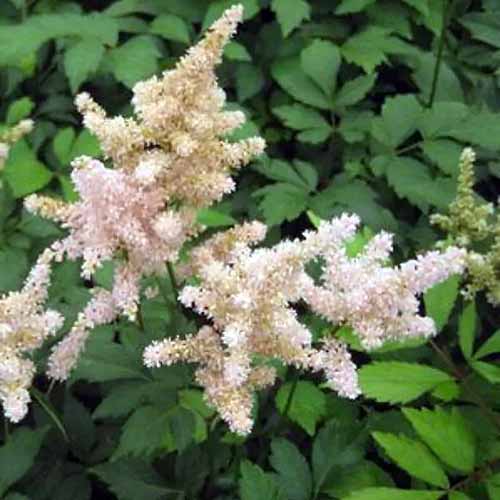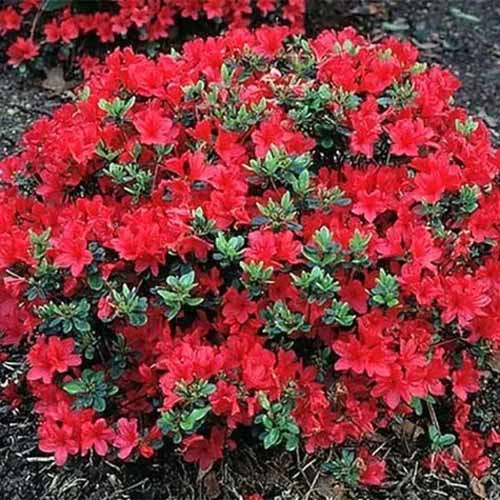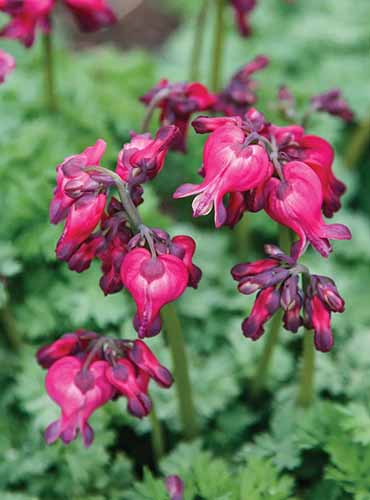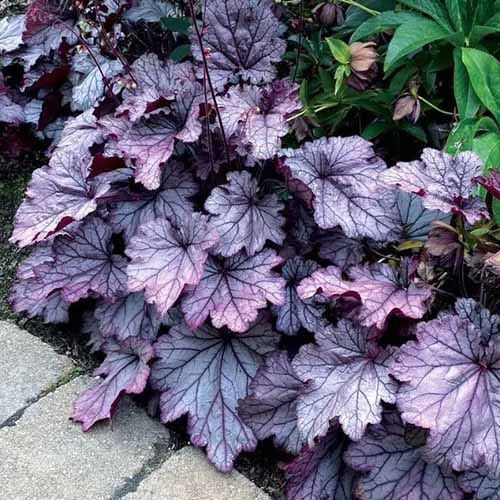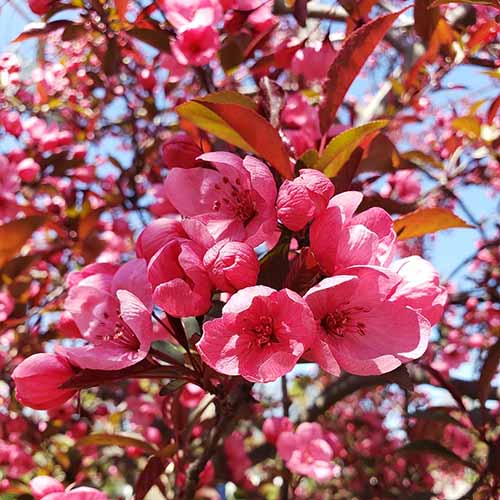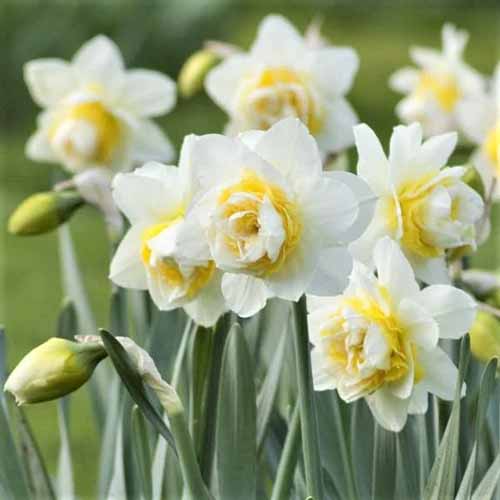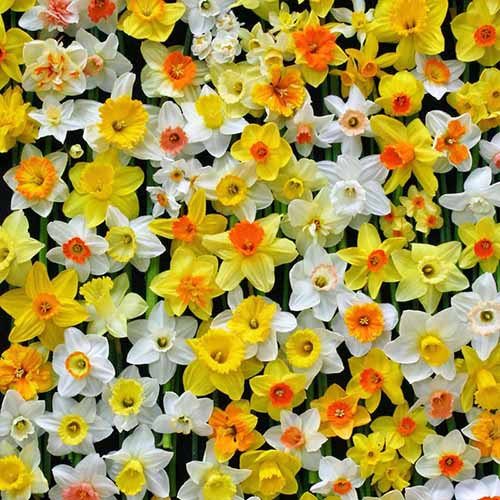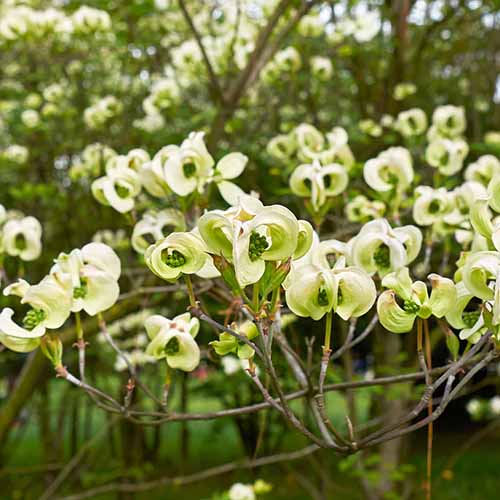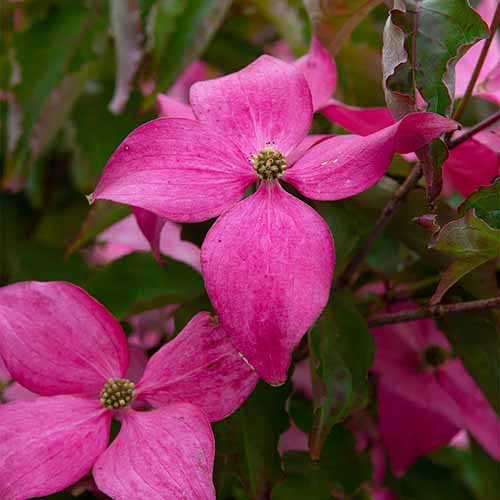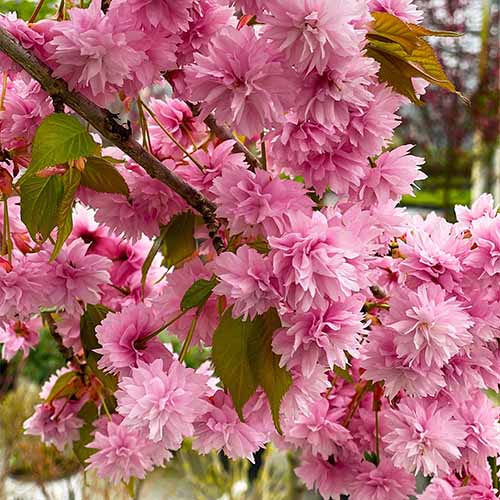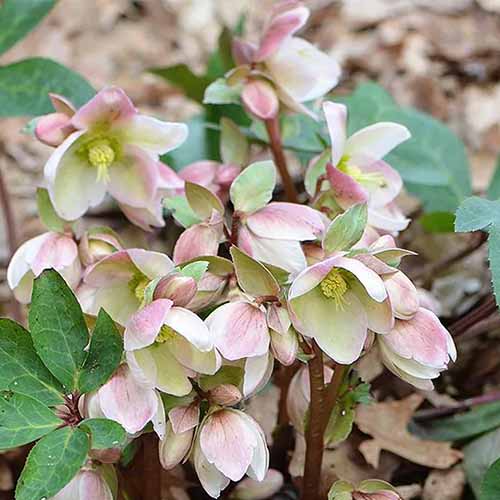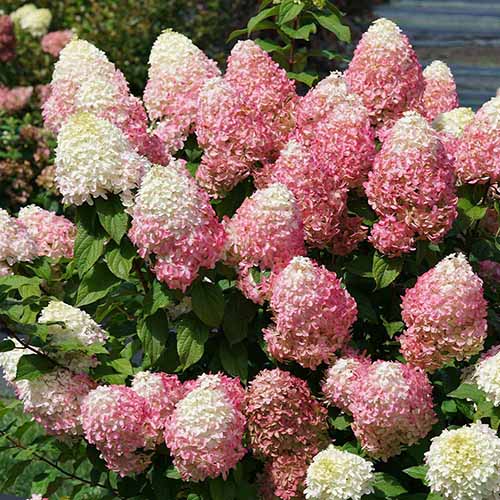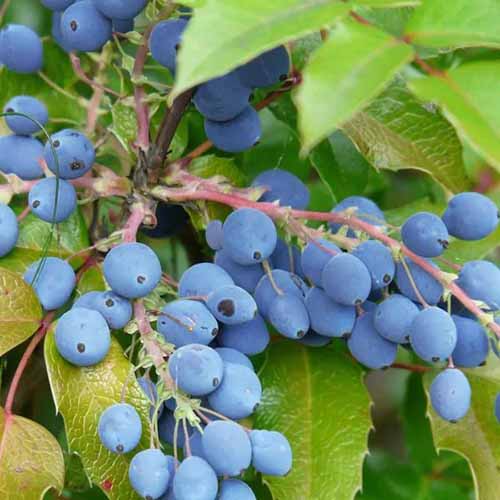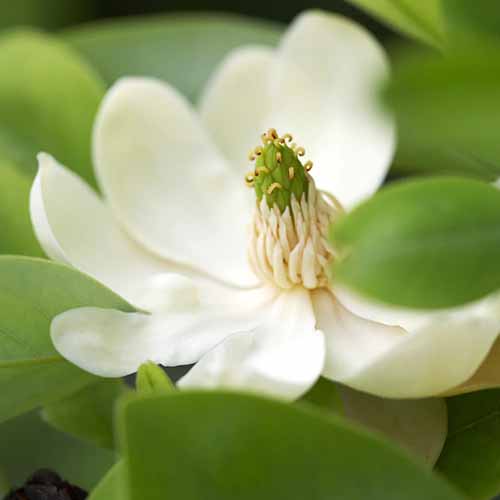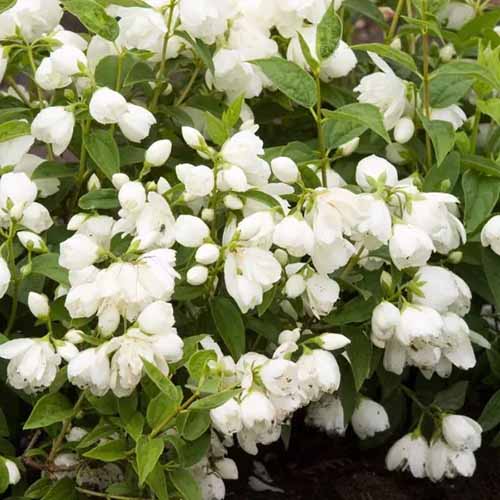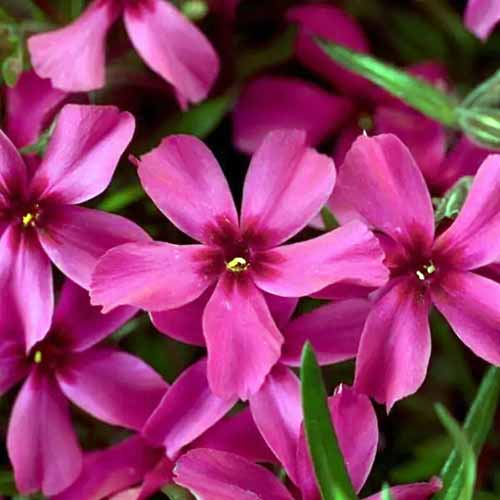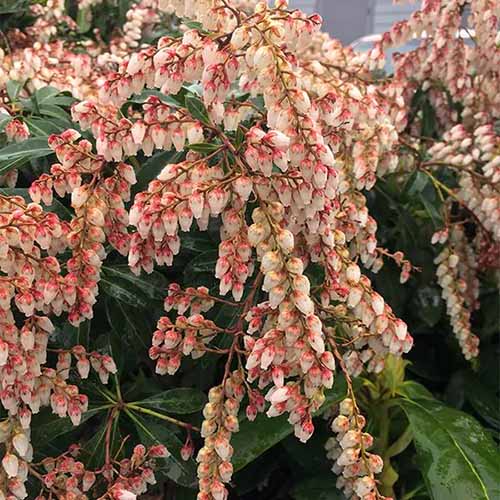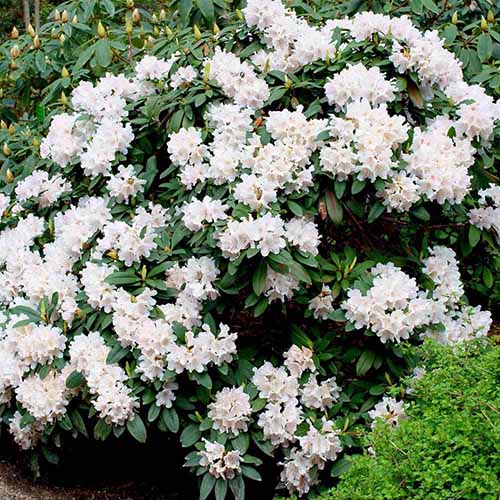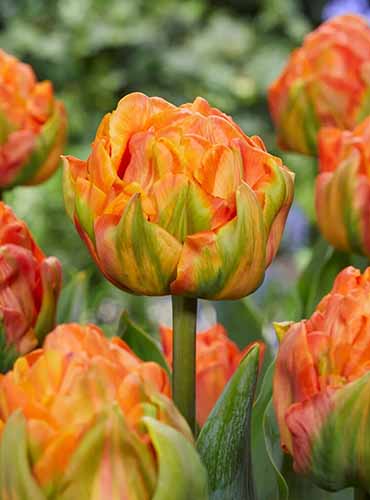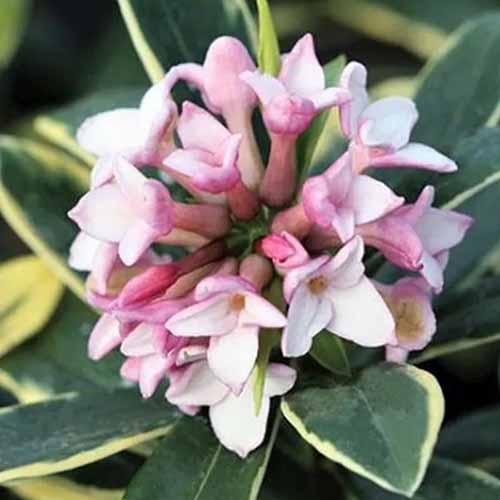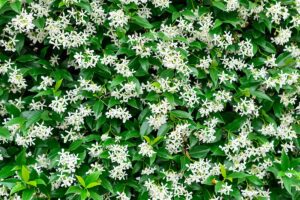When my camellias are in full bloom, they grab my attention – I can’t help but admire them every time I peek outside or walk through my garden.
I couldn’t even imagine planting something nearby that would draw the eye away from the stunning blooms.
But then in the summer when they’re not blooming, they kind of need something to pick up the slack. Not that the glossy foliage isn’t beautiful, but it just needs a little something, you know?

We link to vendors to help you find relevant products. If you buy from one of our links, we may earn a commission.
So I planted a bunch of companions around my camellias, like ferns, bleeding hearts, and dogwoods. And you know what? These plantings complement my camellias, even when they are blooming.
The lesson here? Companions are always a good idea! And there are lots of options.
In our guide to growing camellias, we discuss how to grow these shrubs in your garden. In this guide, we’ll look at 39 of the best companion plants for your camellias.
Here’s the lineup:
39 Top Companion Plants for Camellias
Camellias hail from temperate environments, with neither too much heat nor too much cold.
The first thing you should ask yourself when choosing a friend for your camellia is if the plant has the same water requirements.
Differing sun needs can be accommodated, but if you plant your thirsty camellia next to a big old barrel cactus, you’re going to lose one or the other.
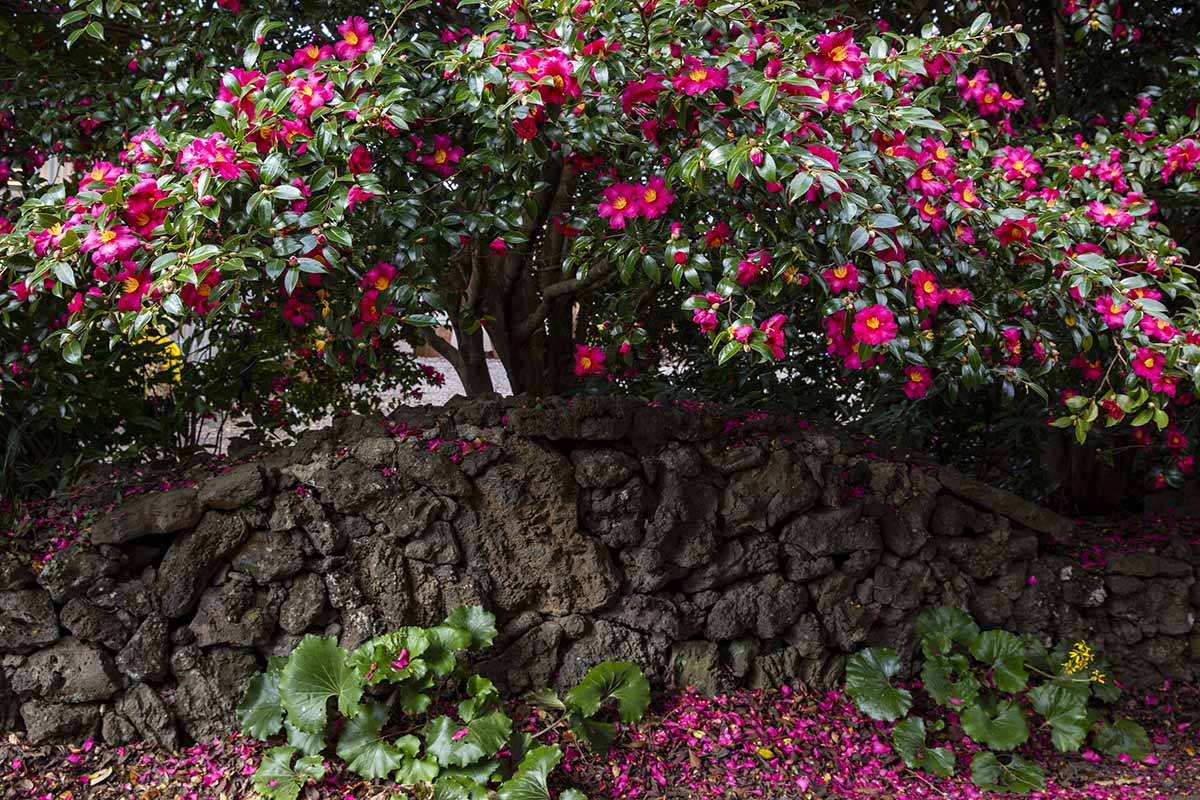
The other consideration is soil pH. Camellias like things acidic. That doesn’t mean anything you plant near it also needs to love acidic soil, but it needs to at least tolerate it. Don’t even think of a plant that demands alkaline soil.
There’s a difference between tolerance and demand. For instance, lilacs prefer soil that’s a touch alkaline, but I have multiple lilacs and camellias growing and thriving right next to each other.
Both are adaptable. In fact, I find most plants are adaptable unless they require a pH on one extreme end or the other.
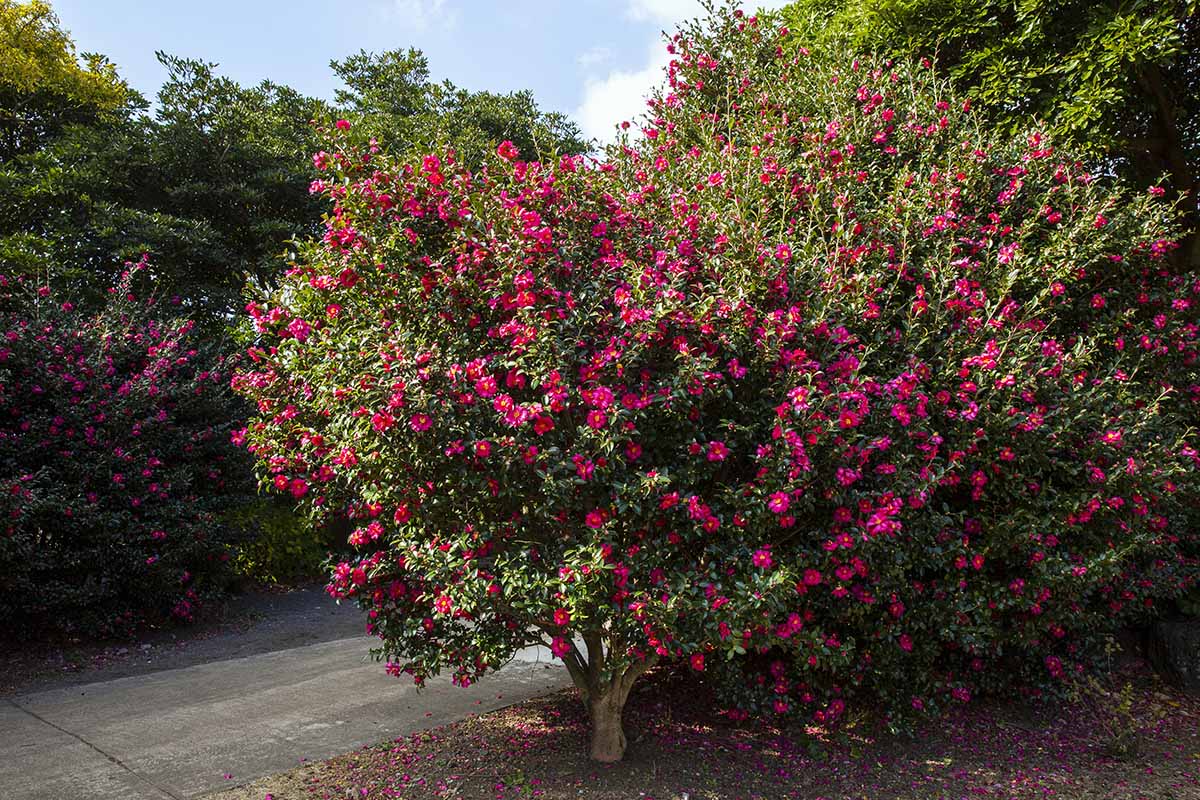
Similarly, camellias are often described as requiring at least some shade during the day. But if you live in a cooler area, they will be fine with full sun. Or, plant them next to something like a magnolia that provides afternoon shade.
Camellias grow in USDA Hardiness Zones 6 to 10, depending on the cultivar.
Here are the top companions to plant with your camellia shrubs:
1. Acacia
Acacia is a huge genus that encompasses a large number of species, as well as a variety of cultivars, like ‘Cousin Itt,’ which is an A. cognata cultivar that grows in Zones 9 to 11.
It’s an adorable option for adding a little variety. This small shrub looks like a green Cousin Itt from the Addams Family, with shaggy green hair-like leaves. It reaches three feet tall and five feet wide when mature.
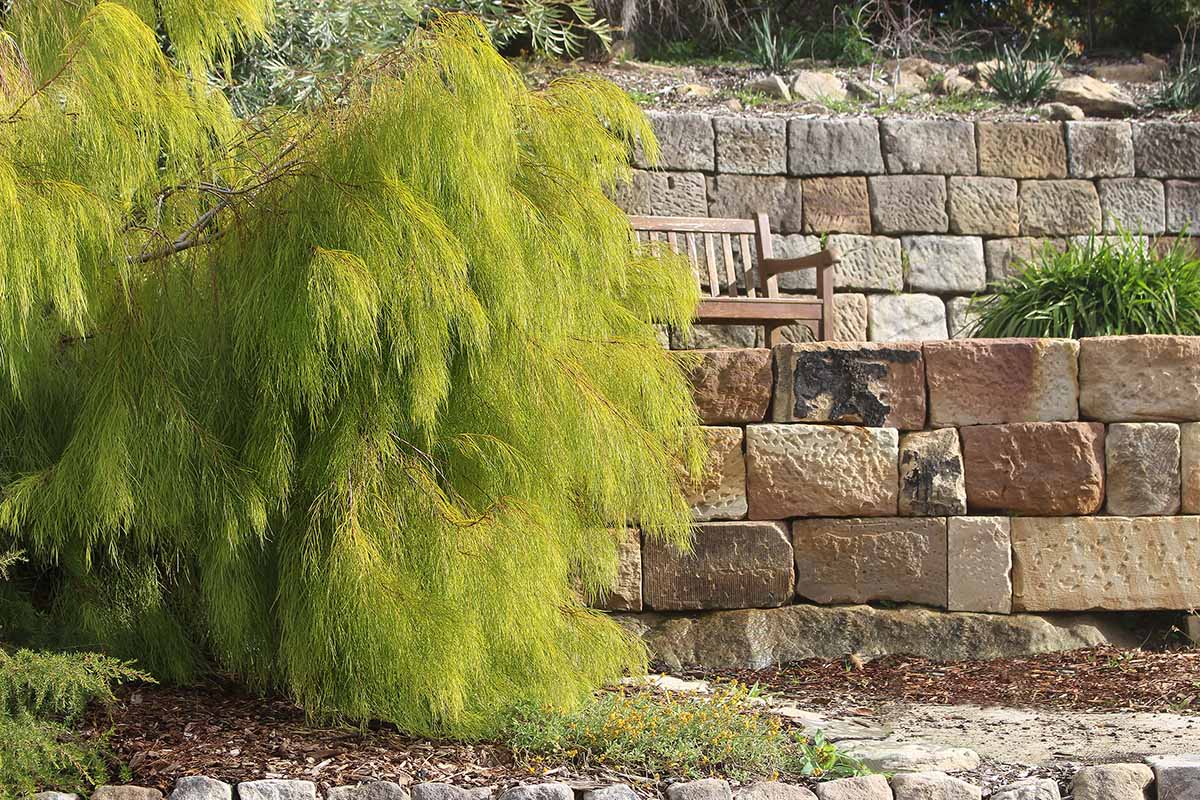
Imagine the funky evergreen plant hanging out with your camellias. Cute, right? Just don’t overwater it. It’s picky about moisture and doesn’t want too much.
Acacia plants need partial to full sun, so don’t plant them under your camellias. They should be nearby but not in the shade of larger plants.
2. Astilbe
When you mention shade-loving bloomers, you’re going to hear hostas, hellebores, and astilbe (Astilbe spp.). The fuzzy, vibrant spikes of flowers are just too incredible to pass up.
These plants can grow anywhere from one to six feet tall, depending on the species.
This perennial blooms from early to late summer, depending on the species, even in dense shade in Zones 3 to 9. They need hardly any attention to look their best, all while providing a colorful contrast to the summer green of camellias.
I personally think that ‘Peach Blossom’ is a particularly pretty hybrid, with its large, peachy feather-like flowers. You can bring one home from Nature Hills Nursery in a #1 container.
Learn more about growing astilbe in our guide.
3. Aucuba
Aucuba (Aucuba spp.) are evergreen shrubs that grow six to 10 feet tall, with glossy leaves. They somewhat resemble laurels or camellias, and they like the same conditions, so the plants are often confused.

But aucuba don’t have the showy blossoms of camellias, though they do produce pretty red drupes. What makes them stand out, though, is the fascinating foliage.
The leaves can have cream or white splotches, spots, or other patterns of variegated color.
While the japonica species is the most popular, any in this genus has something to offer those who live in Zones 6 to 9.
Plant them near your camellias but far enough away that they’ll receive full sun.
4. Azalea
Azaleas (Rhododendron spp.) and camellias have very similar requirements but bloom at different times, so you can enjoy a colorful show for a larger portion of the year.
Camellias bloom anywhere from late fall to midspring, while azaleas are performing in the spring, summer, or early fall, depending on the cultivar.
Both plants like acidic soil with a pH somewhere near 5.5 and both tolerate semi-shade positions with around four hours of direct light per day.
They both need about the same amount of water, typically when the top inch or two of soil has dried out.
‘Hino Crimson’ is particularly floriferous and eye-catching with its bold red blossoms. It’s available at Nature Hills Nursery in #3 containers.
Azaleas grow in Zones 6 to 9, though there are a few that can tolerate life in Zone 5. The plants can range from a foot tall to over 20 feet tall, depending on the species or cultivar.
If you choose a smaller one, you can plant it under your camellia, while larger ones can be planted nearby with some afternoon shade.
Learn more about how to grow azaleas in our guide.
5. Begonia
Tuberous begonias (Begonia x tuberhybrida) are foot-tall winter bloomers that can add an additional punch of color underneath your camellias. They bloom at the same time and begonias will grow happily in the dappled shade of your shrubs.
If you’re in Zones 9 or 10, you can enjoy the pairing and kiss the winter blues goodbye. Begonias will even bloom a bit before and after most camellias are flowering, so they’ll keep the performance going.
What about something like ‘Roseform Yellow’ and its pretty yellow blossoms? You can find this option at Nature Hills.
You can find our guide to growing tuberous begonias here.
6. Bergenia
You have to be really careful when you pick a type of bergenia (Bergenia spp.) because most species grow in Zones 4 to 6 and others can grow up to Zone 9.
At 18 inches tall, they can grow under or next to your camellias in part to full shade.
If you want them to complement your camellia, you need to pick one that is compatible with your growing zone.
For instance, B. cordifolia ‘Winter Glow’ is good to go in Zones 3 to 8 and when the fuchsia-red flowers aren’t present, the bronze foliage will draw the eye.
Sound good for your garden? You can bring one home from Nature Hills Nursery.
You can learn more about how to grow bergenia in our guide.
7. Bleeding Heart
Bleeding hearts (Lamprocapnos spectabilis and Dicentra spp.) are such delicate, subtle woodland plants.
I have some Pacific bleeding hearts (Dicentra formosa) under some of my camellias that I’ve pruned into a tree shape, and their sweet early spring blossoms never fail to make me smile.
Because they tolerate a good deal of shade, they can be planted under or next to your camellias where they will be protected from harsh sun.
I think they’re all the more special for how short their blooming season is. You can find bleeding hearts for Zones 3 to 9 in colors like pink, red, purple, and white in sizes up to four feet tall.
‘King of Hearts’ Bleeding Heart
Or how about something in both pink and purple with a hint of white? That’s what ‘King of Hearts’ has.
The blossoms form in tight clusters and last for a long time. Nab a bare root from Burpee.
Check out our guide to growing bleeding hearts to learn more.
8. Bugleweed
The great thing about bugleweed (Ajuga spp.) is that you’d be hard pressed to find a place where this mint relative won’t grow. If you need something tough and reliable with pretty purple flowers, this is one to pick.
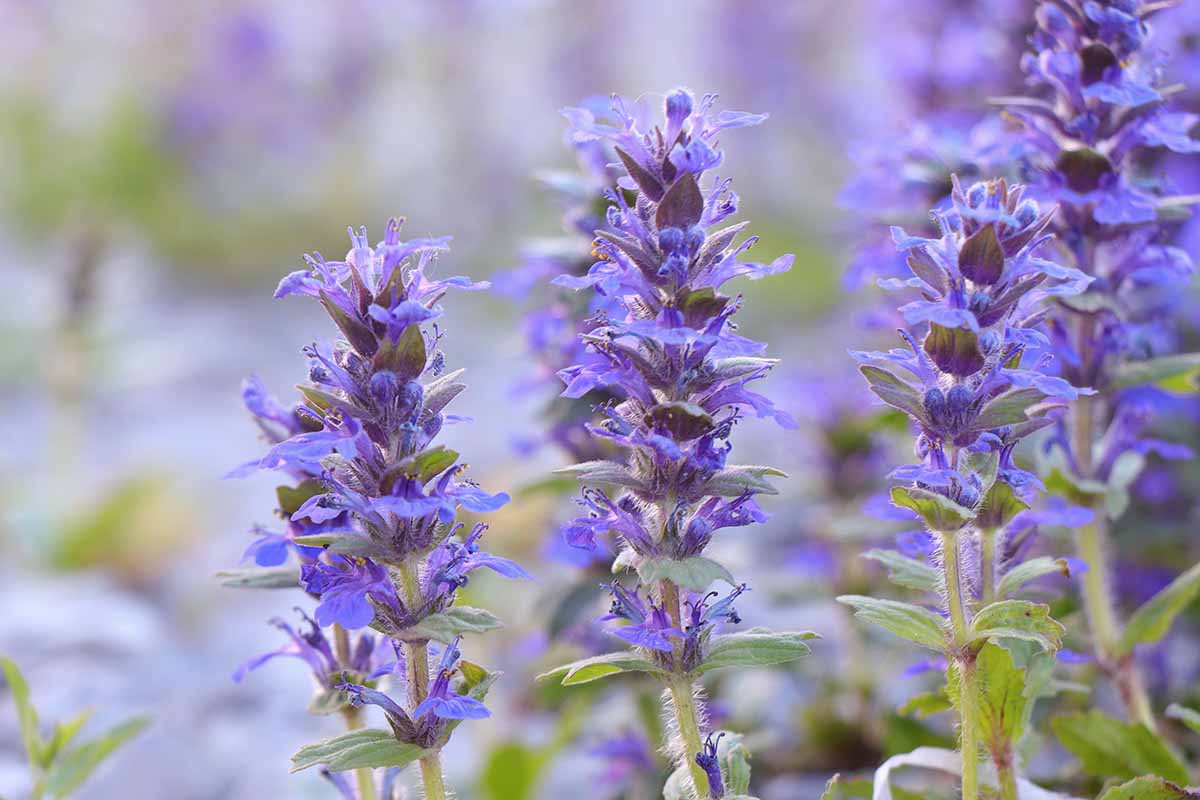
Just be aware that its gregarious nature can be a bit overbearing. It might want to spread into your lawn and other parts of your garden in Zones 4 to 9 if you aren’t careful.
Still, the pretty bronze-green leaves and purple flowers might just be a welcome addition wherever it creeps.
Because bugleweed only grows about six to nine inches tall, it’s perfect as a carpet on the south side of the camellia, since it needs partial sun. It will probably spread underneath the plant, but start on the south side and see where it wants to go.
Home Depot carries this enthusiastic plant in packs of six.
If you just don’t want to have to weed underneath your camellias anymore, you’ve found the answer.
9. Coral Bells
I can’t get enough of coral bells (Heuchera spp.). Like most plants primarily grown for their foliage, they tend to be overlooked for something that can put on a showier performance.
Don’t ignore these plants, though. The foliage can have such fascinating patterns that they might as well be flowers.
Most species grow in Zones 4 to 9, though you can find outliers, and they’re just as happy in full sun as full shade, depending on the cultivar.
I truly don’t know how they can be so adaptable. Plant them under or next to your shrubs, depending on your needs and the cultivar you choose.
You’ll be spellbound by the rose purple, heavily ruffled leaves of ‘Spellbound.’ You can buy it at Nature Hills in a #1 container.
Learn more about growing heuchera in our comprehensive guide.
10. Crabapple
Let’s hear it for crabapples (Malus spp.). They put on a killer floral display in the spring, are much tougher than their apple cousins (and crabapples are also edible!), and they’ll happily grow paired up with camellias.
You can find petite options around seven feet tall that will act as a centerpiece to the shrubby frame when planted in front of a row of large camellias or go for a larger option to plant nearby.
Full-sized trees grow about 20 feet tall. Anyone in Zones 4 to 8 can enjoy these pretty trees.
If you want a crab apple that puts on a seriously impressive performance, check out ‘Show Time.’
Available at Fast Growing Trees in a variety of sizes, it has huge, double blossoms in a gorgeous pink hue.
Learn more about growing crabapples in our guide.
11. Cyclamen
I hear what you’re saying, cyclamen (Cyclamen persicum) are only hardy in Zones 9 to 11. There’s only a tiny growing zone overlap with camellias.
While that’s true, cyclamen are fabulous as foliage annuals, or you can dig them up at the end of the growing season and grow them as houseplants.
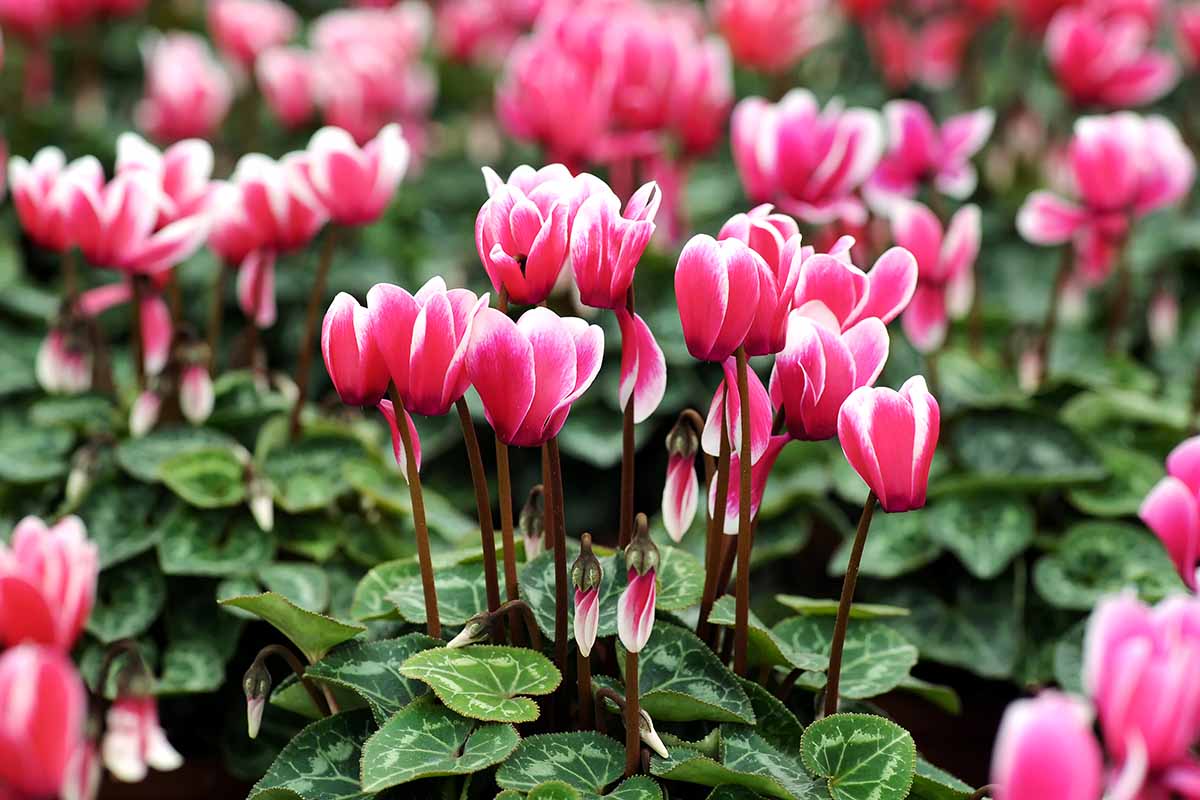
Those that can enjoy both will have a vibrant winter display, with cyclamen blooms covering the ground and camellias covering the vertical show.
Otherwise, let the striking foliage add a pleasing element to the area surrounding or underneath your camellia shrubs.
Since they only grow between six to 18 inches tall, they can serve as a colorful carpet or a side addition in a shady area.
Bring home a five pack of bulbs with silver and green variegated foliage and purple-pink blossoms from Home Depot.
12. Daffodil
If you want some bright color underneath a tree-shaped camellia, you can’t go wrong with daffodils. Imagine some frilly ‘White Lion’ blooming at the same time as your camellias.
‘White Lion’ has fragrant, white and cream flowers with hints of yellow that grow up to 16 inches tall and can be found at Eden Brothers.
Or, if you want a more classic display that will last for months, grab the All Star Mix from Eden Brothers, which contains a mix of cultivars that take turns blooming, with early, mid, and late flowering types.
One of the big differences between the growing requirements of daffodils and camellias is that daffodils really must have full sun to bloom beautifully, though you might get away with a tiny bit of shade. For that reason, they’re best kept on the south side of your shrubs.
Otherwise, they do well with the same water and pH needs as camellias, and they grow in Zones 3 to 8.
You can learn more about growing daffodils in our guide.
13. Deutzia
I’m so happy that deutzia (Deutzia spp.) is finally gaining some attention from home gardeners.
These plants have such marvelous white or pink blossoms in the early spring, covering them so densely that you can hardly see the foliage.
And speaking of foliage, it turns chartreuse or gold in the fall, adding yet another layer of interest when your camellias are in their summer cloak.
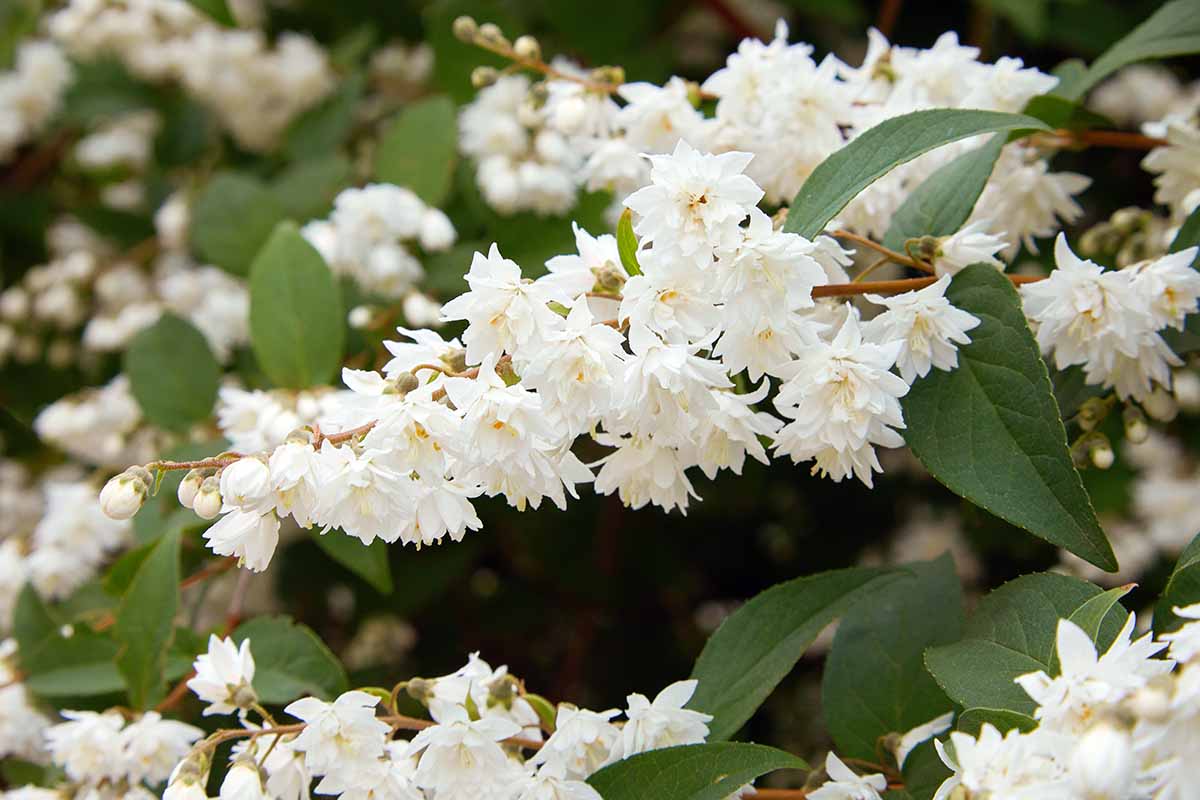
Deutzia grows in Zones 5 to 8 and need full sun to look their best, so don’t let your camellia plants shade them.
Plant them nearby on the east, west, or south side – but avoid the north side. Depending on the species, they can grow from one to 10 feet tall.
Visit Home Depot to pick up a live plant with cherry pink blossoms in a four-and-a-half-quart container.
14. Dogwood
Dogwoods (Cornus spp.) come in all shapes and sizes, but what they have in common are some spectacular blossoms and leaves.
While you don’t want to shade a camellia too much or you’ll compromise the floral show, so long as you don’t plant your shrub right underneath your dogwood, they will be perfectly happy together.
Or you can plant creeping dogwood (C. canadensis) aka bunchberry, and let it fill in around your shrubs. Both trees and shrubs can grow in Zones 5 to 9.
These spring bloomers can overlap with the camellia bloom or they can take the baton as the flowers are fading.
I have a dying walnut tree that is on its last legs. Once it’s gone, I am itching to replace it with a Mexican flowering dogwood (C. florida var. urbiniana).
The unusual flowers are like nothing else I’ve ever seen. If that particular tree interests you, visit Fast Growing Trees to pick up a three- to four-foot specimen.
Or go with something a bit more classic, with the bright reddish-pink blossoms of C. kousa ‘Scarlet Fire.’
This is a kousa dogwood and it can also be found at Fast Growing Trees in a four to five foot height.
Be sure to check our our dogwood care guide for more info.
15. Fern
You have a lot of options when it comes to ferns. There are at least 10,000 recorded species and a lot more that haven’t been identified yet.
There are hundreds that are common in gardens. Find one that grows in your Zone and has the shape you want and go to town. Ferns will provide interest underneath even the tallest camellia.
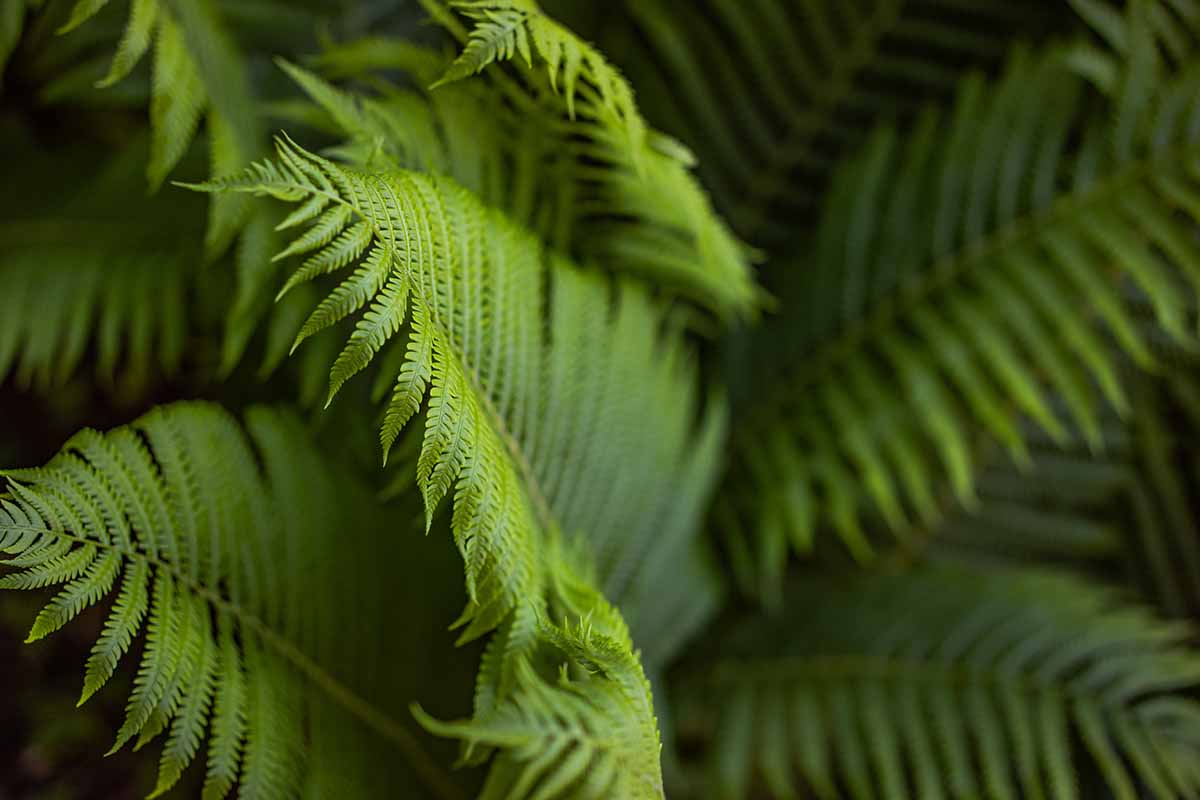
I personally have maidenhair ferns (Adiantum pedatum) and sword ferns (Polystichum munitum) under my camellias, but cinnamon (Osmundastrum cinnamomeum) or lady ferns (Athyrium filix-femina) would be awesome choices, as well.
Learn more about growing ferns in our guide.
16. Flowering Cherry
Ornamental cherries (Prunus spp.) are spring royalty. There are festivals, parades, and ceremonies all dedicated to the joy of the spring bloom.
Combine that with a camellia draped in a cloak of flowers and you’ll have a spectacular display. You’ll be looking forward to spring all year long.
Pick a small weeping type to grow in front of some tall camellia shrubs or go with something taller and place your shrubs nearby. Flowering cherries grow well in Zones 5 to 8.
Weeping Extraordinaire™ Flowering Cherry
You can’t go wrong with any of the beautiful options out there, but Weeping Extraordinaire™aka ‘Extrazam’ is a showstopper. The fluffy, frilly pink blossoms are stunners.
Visit Fast Growing Trees for a four- to five- or five- to six-foot tree.
Learn all the ins and outs of growing flowering cherries in our complete guide.
17. Foamflower
I’m all for adding native species to our gardens when possible, and foamflower (Tiarella cordifolia) is native to eastern North America that dazzles with masses of pinkish-white blossoms that look like seafoam floating through your garden.
The plants reach one to two feet tall.
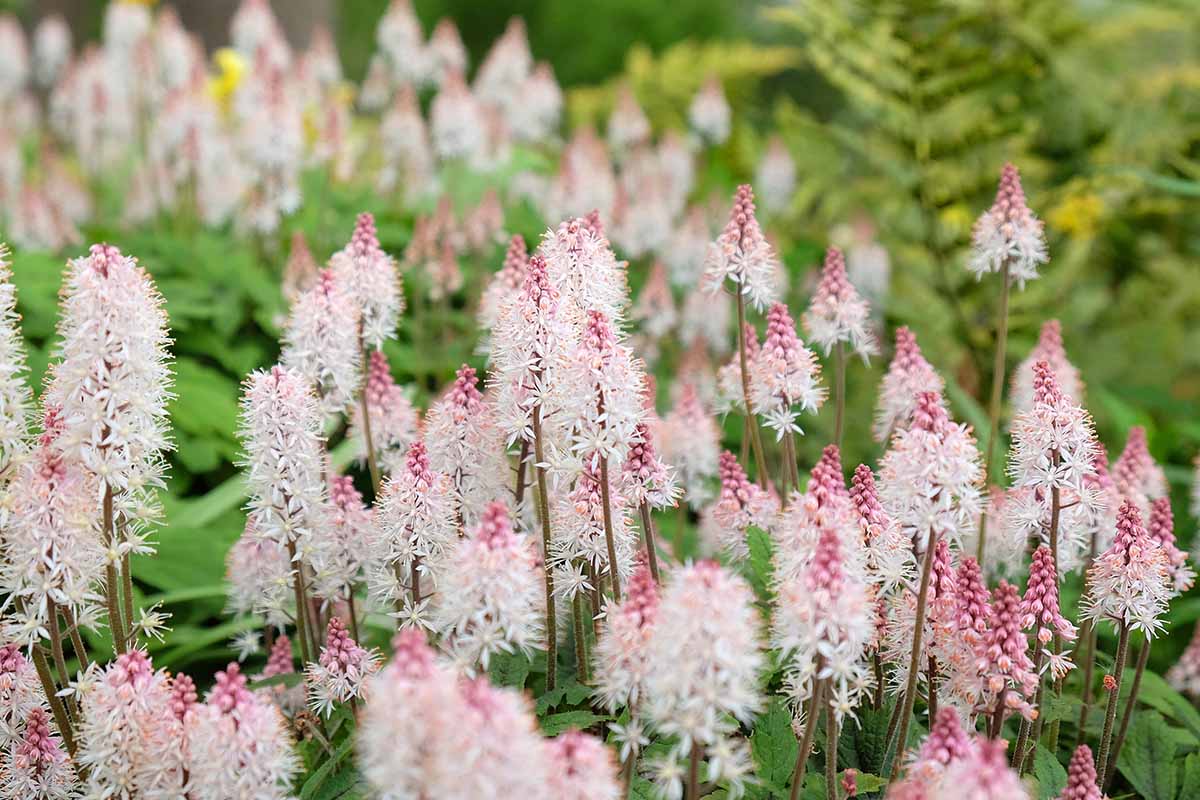
They bloom in the spring and are hardy in Zones 3 to 8, but what I like best is that they perform wonderfully in full shade.
That means you can fill in the empty space underneath your shrubs with something that will blossom when your camellias are wearing their green outfit.
18. Fuchsia
Whether you place a few hanging baskets near your camellia shrubs or plant some low-growers underneath, fuchsia (Fuchsia spp.) make a striking contrast to the green camellia leaves with their bright blossoms that last through spring, summer, and fall.

Since fuchsias will tolerate shade, they’re perfect for adding interest to the north side or underneath camellia shrubs.
Tender fuchsias can grow in Zones 10 to 11, or you can overwinter them. Half-hardy types are good down to Zone 9 and hardy varieties can grow down to Zone 7 with some winter protection.
If you’d like to know more, visit our guide to growing fuchsia.
19. Gardenia
Gorgeous gardenias (Gardenia spp.) only grow in Zones 8 to 11, so there’s just a small overlap with camellias. But if you are in Zones 8 to 10, you can grow these two plants together.
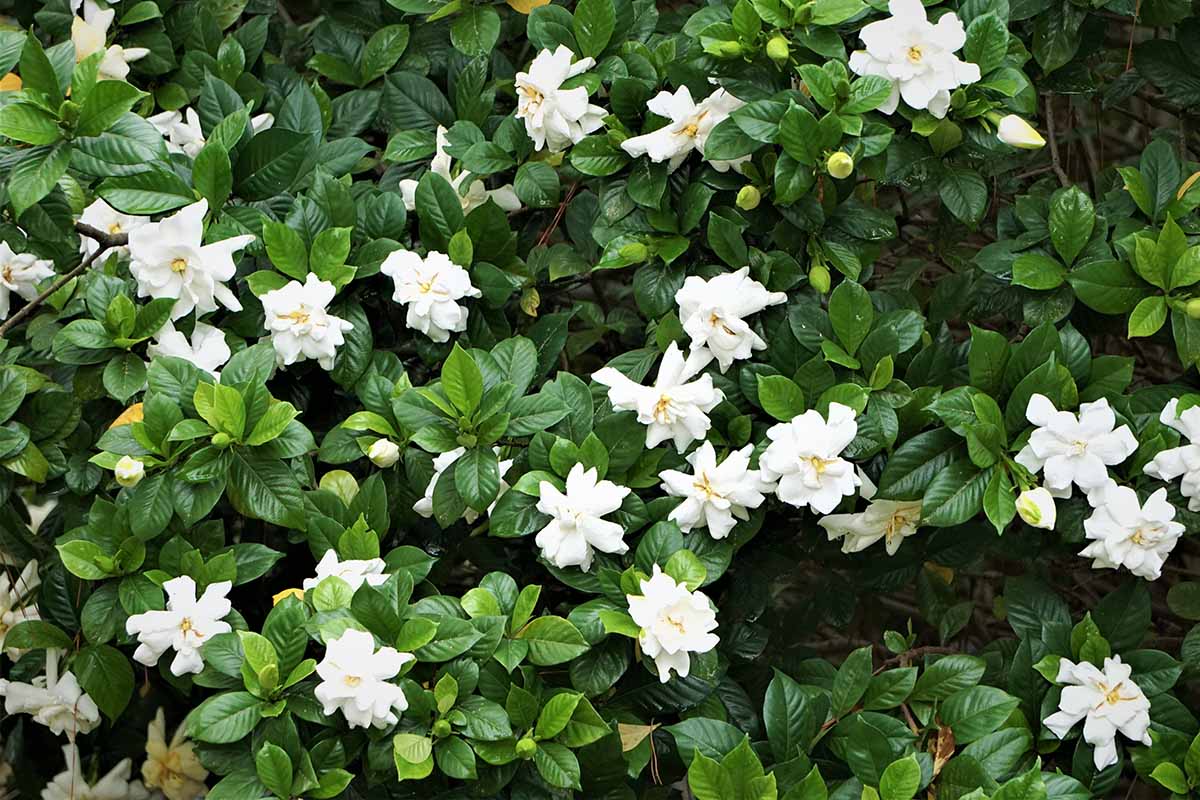
Gardenias need the same moisture and soil pH that camellias do, and they like morning sun and afternoon shade, which is another similarity.
They bloom in late spring and early summer and are around the same size as camellias, so plant them near each other and let the gardenias take over the blooming duties as the camellia flowers fade.
G. jasminoides ‘Frostproof’ lives up to its name. It has all that phenomenal scent and won’t collapse at the first sign of frost. It will thrive in Zones 7 to 10.
Bring ‘Frostproof’ home from Nature Hills in a quart or #3 container.
Growing gardenias is much easier than you might expect. Our guide shows you how.
20. Geranium
Whether you prefer the scented (Pelargonium spp.), wild (Geranium maculatum and G. oreganum), garden (P. x hortorum), or ivy (P. peltatum), geraniums offer joyful color at the base of your camellia plants when they aren’t in bloom.
Many gardeners grow geraniums as annuals, but depending on the species, they can be grown as perennials in Zones 3 to 9.
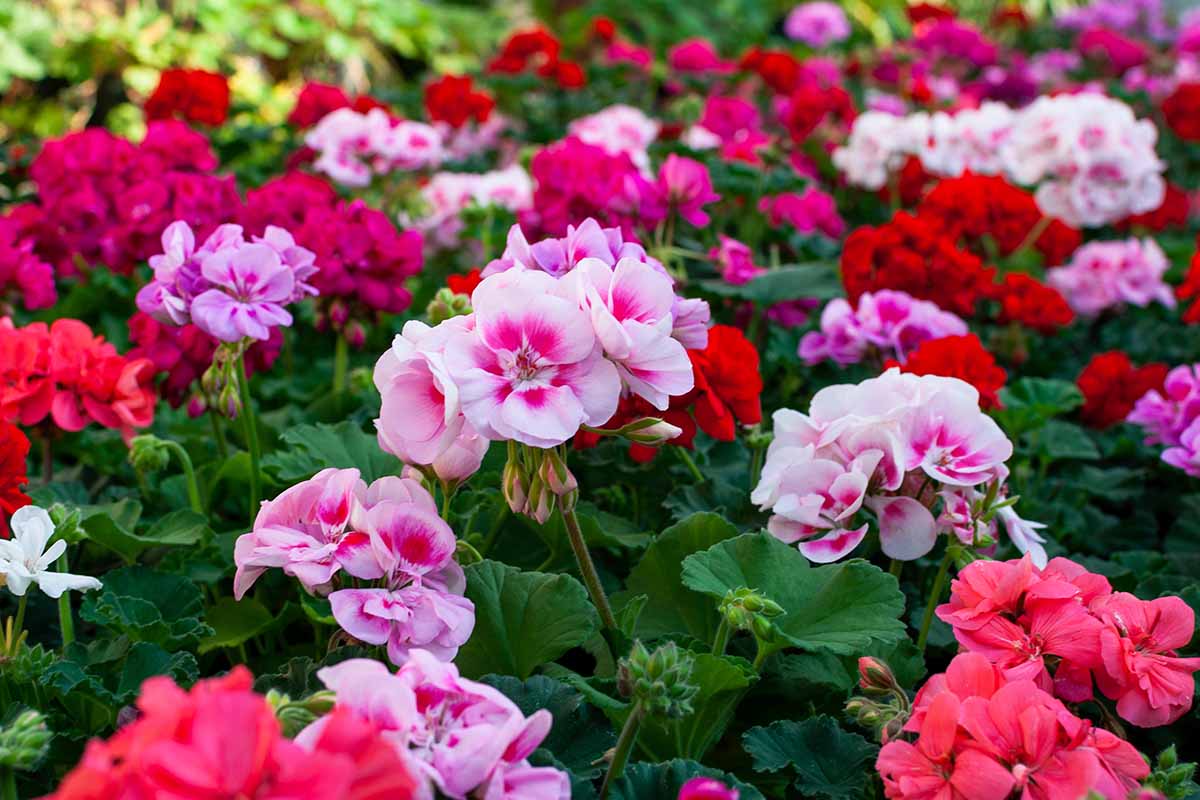
Those in the Pelargonium genus do best in full sun, so plant them on the south side of your shrubs.
Wild geraniums are native to North American woodlands and thrive in shade, so they can fill in the north side of or be grown underneath your camellias.
Learn more about growing geraniums in our guide.
21. Hellebore
Even during the summer when they’re not in bloom, hellebores are so pretty, I would even grow them for the foliage alone.
But when Lenten roses start flowering in the depths of winter, I want to wrap them in my arms and hug them.
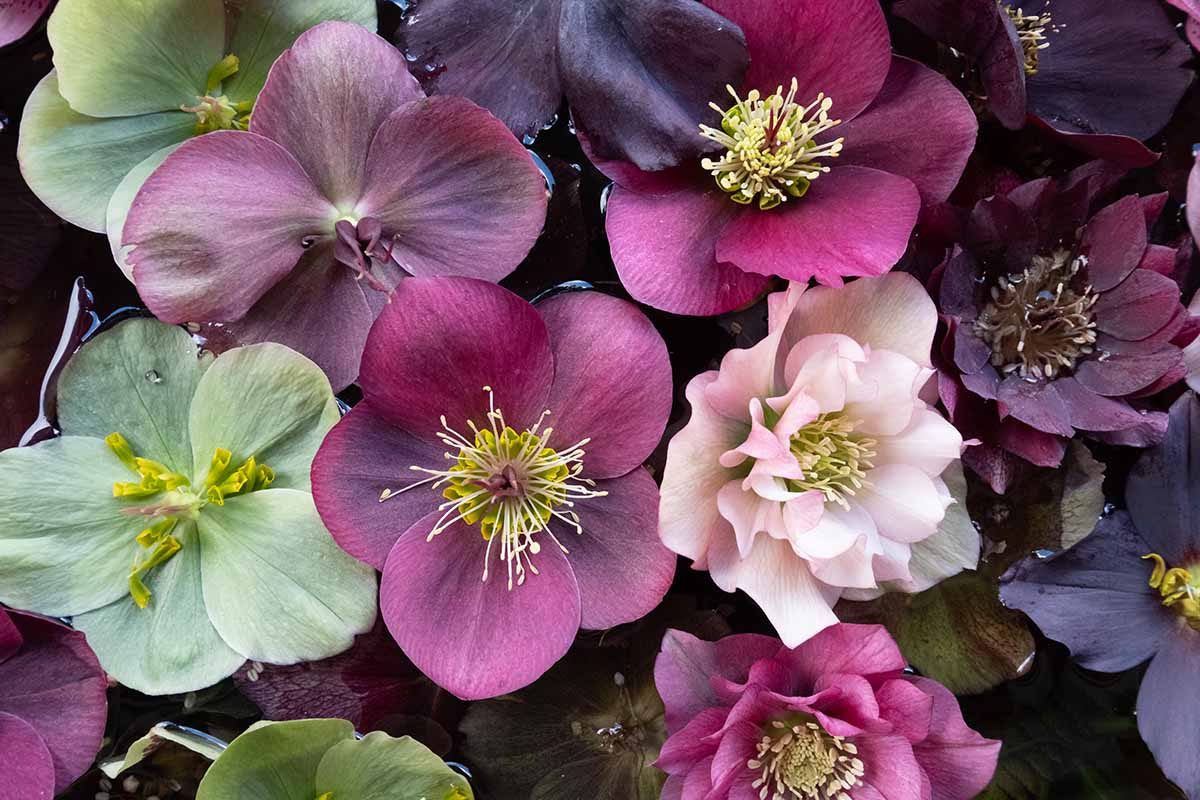
That they bloom even in shade with their unique green, purple, pink, red, white, or yellow blossoms makes them even more enjoyable.
Plant some of these short plants, which stay under 18 inches tall, at the base of your camellias and you have a colorful show in winter from the ground on up.
Hellebores are hardy in Zones 4 to 9.
I love some of the more unusual colors, like ‘Ivory Prince,’ with its blush pink, chartreuse, and ivory blossoms. It’s available for purchase at Nature Hills Nursery.
Consult our guide to growing hellebores for more information.
22. Hosta
Hostas are garden staples. You’d be hard-pressed to find a yard in Zones 3 to 9 that doesn’t have at least one filling in a shady spot.
They’re just so perfect for adding color and texture in locations where many other plants refuse to grow.
Plus, they play so well with many other plantings, acting as a highlight or a centerpiece depending on how you use them. As a companion for camellias, they will provide texture and color at the base of the shrubs from spring until the first frost.
There’s absolutely nothing wrong with a classic hosta, but I’m kind of in love with ‘Abiqua Drinking Gourd’ right now.
The cupped, wrinkled leaves are so cool. You should see them after it rains or when they are covered in dew. They sparkle with the captured drops.
Buy one (get a few for me, too) at Nature Hills Nursery in a #1 container.
Learn more about hostas in our growing guide.
23. Hydrangea
Hydrangeas (Hydrangea spp.) complement camellias perfectly. During the season when your camellia plants aren’t in bloom, hydrangeas pick up the slack in Zones 3 to 9.
Hydrangeas can tolerate soil pH between 5.5 and 6.5, have similar water needs, and can thrive in part shade. In other words, they like the same things camellias do.
Typically, hydrangeas are smaller than camellias but some can grow up to 15 feet tall, so they can provide a different height layer. Be sure to plant smaller hydrangeas in front or they will quickly disappear from view.
I’m obsessed with Quick Fire® right now. It’s a panicle (H. paniculata) cultivar with white blossoms that eventually turn rose red. They bloom for a good, long time from summer well into the fall, before the leaves turn burgundy.
Fast Growing Trees has ‘Quick Fire’ available in three-gallon containers.
Hop on over to our guide on hydrangeas to learn more about raising these beauties.
24. Japanese Aralia
Paperplant or Japanese aralia (Fatsia japonica) has huge, palmate leaves that come in a surprising array of variegated patterns and colors.
When you have one of these shade lovers growing in your garden, it always draws comments because the glossy leaves look like someone transported a tender tropical plant to your average temperate garden in Zones 8 to 10.
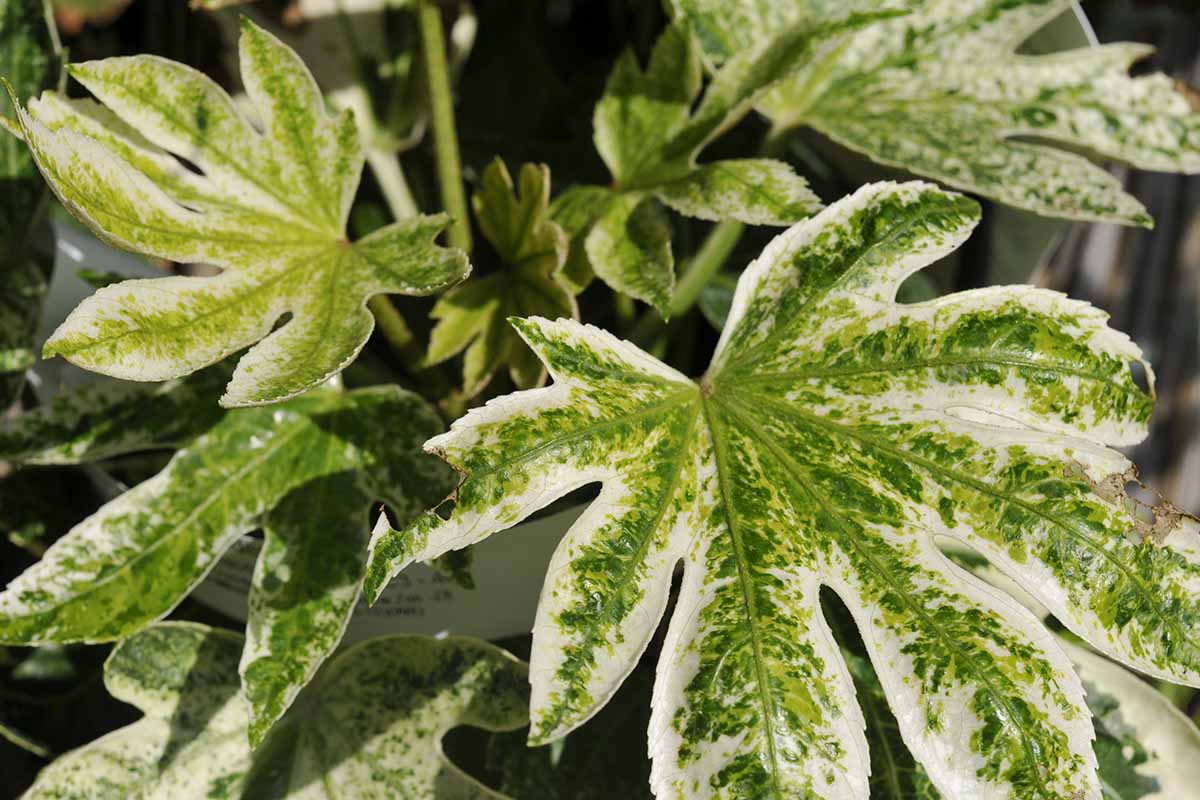
You can grow them as houseplants, too, but as a companion for a camellia, they provide a contrasting shape and hue that takes things from wow to wowza.
Plant smaller cultivars under the shrubs, while taller cultivars, which can reach up to eight feet tall, should be planted nearby where they’ll be protected from full sun exposure.
The fuzzy little balls that appear in the summer are just a huge bonus.
25. Japanese Maple
Japanese maples (Acer spp.) offer a different look from some of the other plants on this list because they are deciduous trees. Camellias will provide the winter color and spring is when the maples take over.
With dramatic, colorful foliage, even though they don’t bloom, they add a striking contrast to the green foliage of the camellia.

Japanese maples prefer moderately acidic soil, with a pH between 5.5 to 6.5 and similar water requirements. They like afternoon shade, so they’d make a nice pairing with camellias on the east side of a house or larger tree in Zones 5 to 8.
It’s impossible for me to recommend a single Japanese maple. There are just too many good ones to choose from, in heights from just a few feet tall to 20 feet or more.
But if I had to pick, ‘Inaba Shidare’ would definitely top the charts. It won’t lose its bright red to purple color in the heat and the weeping form is so elegant.
The plant can eventually grow ten feet tall over several decades, but it typically stays smaller, especially in lower light.
‘Inaba Shidare’ Japanese Maple
In the spring, the foliage is nearly black and then turns fire-engine red in the fall.
Maple Ridge Nursery carries this beauty in a 15 and 25 gallon size.
You can learn all about how to grow Japanese maples here.
26. Mahonia
Mahonia (Mahonia spp. and Berberis spp.) might not be the first plant that comes to mind as a friend for your camellia, but they get along nicely.

Mahonia doesn’t mind a little shade, so you can plant it in the shadow of a taller camellia shrub, they both have similar moisture requirements, and both come in a variety of sizes and shapes complement or contrast each other.
Mahonia blooms in the spring and summer, with the pretty blue berries close behind. Then, in the winter, your camellias will pick up the slack.
Plus, since camellias rarely have yellow blossoms, mahonia adds that missing hue.
Depending on the species, they grow well in Zones 4 to 9.
The classic Oregon grape (Berberis aquifolium) is good for Zones 5 to 9 and is available in both a standard, six-foot shrub, and dwarf size that stays under two feet tall.
Nature Hills carries the dwarf as well as the full-sized option.
Learn more about growing Oregon grape in our guide.
27. Magnolia
You’ll find magnolias (Magnolia spp.) that grow everywhere from Zone 4 to Zone 10 in heights that range from eight to 80 feet.
Since they have similar environmental needs in terms of water, soil pH, and light, you can grow a towering magnolia to shade your camellia in the afternoon, or grow a dwarf tree that adds a little height in the background to a few small shrubs.
In my yard, the magnolias pick up the job of blossoming right after the camellias are pretty much done. It’s the perfect transition.
Some magnolias bloom in fall right before the fall-blooming camellias start flowering. They’re the perfect companions.
Visit Fast Growing Trees to grab a sweetbay magnolia (M. virginiana) in a one- to two-, two- to three-, three- to four-, or four- to five-foot size.
Magnolias put on a big show without a lot of fuss, and to learn about their needs, visit our guide.
28. Mock Orange
Every spring, my mock orange shrubs (Philadelphus spp.) surprise me. They’re so unassuming when they aren’t in bloom that I kind of forget they’re there.
Then, suddenly, I step outside and I’m greeted with a fragrance so marvelous that it’s like my olfactory system has been asleep until that moment.
It doesn’t hurt that they start to bloom just as the camellia blossoms are dropping from the plants and the yard needs a boost.
Mock oranges like acidic soil, but they’re adaptable, and they aren’t fussy about water so long as they’re in well-draining soil. They can grow in Zones 4 to 8.
Many sources say that they only grow about eight feet tall, but tell that to the 12-foot tall shrubs growing next to my camellias.
Speaking of, put your mock oranges on the west, east, or south side of your camellias.
‘Snowbelle’ starts blooming in late spring or early summer with clusters of white, fragrant blossoms. Make it yours by visiting Nature Hills Nursery.
Then, learn about growing mock oranges in our comprehensive guide.
29. Pansy
Depending on where you live and which you grow, pansies (Viola spp.) can zing up your garden in spring, summer, fall, or winter.
Some of them do well in partial shade and they bloom reliably for weeks or even months.
Find some in your favorite color and toss them around your camellias to dress things up.
Swiss Giants is an heirloom series with big, boldly-colored blossoms.
While you can find the individual colors sold separately, Botanical Interests combines a striking blend of purple, pink, white, red, orange, and yellow in a 200-milligram pack of seeds.
Just imagine how pretty they would look highlighted against the glossy green of your shrubs.
If you need a little help making them look their best, please visit our guide to growing pansies.
30. Phlox
Both garden phlox (Phlox paniculata) and creeping phlox (P. stolonifera and P. subulata) produce colorful flowers that fill the garden with buzzing bees and bright hues all summer long.
Don’t plant phlox in the shade, though. Stick them on the southern side of your shrubs so they receive full to partial sun.
There are options for anyone in Zones 3 to 9 in colors like pink, purple, blue, white, and red.
The creeping types would be gorgeous on the south side of a shrub, while the upright varieties would look stunning next to your plant on the west, east, or south side.
‘Scarlet Flame’ is a creeping type that sports bright red blooms on four- to six-inch plants.
‘Scarlet Flame’ Creeping Phlox
You can find ‘Scarlet Flame’ available at Nature Hills Nursery in #1 containers.
Or if you prefer a garden type, you could try ‘Cherry Cream’ with cute pink and white blooms atop two-foot-tall plants.
Nature Hills has ‘Cherry Cream’ available in #1 containers.
31. Pieris
Just as the first hint of spring rolls around, pieris (Pieris spp.) puts on its dazzling performance. Japanese pieris (P. japonica) is the most popular species, growing in Zones 4 to 8.
‘Mountain Fire,’ with its variegated cream and green leaves and reddish pink blossoms, is one of the most dazzling cultivars.
The drooping clusters of flowers resemble lily of the valley, which is why this plant is often called lily of the valley shrub. Give it full to partial sun and watch the fireworks of color begin with cultivars like ‘Dorothy Wycoff.’
This one has dark red buds that open into fragrant rose pink flowers in long clusters. The dark green leaves emerge as maroon when they’re young.
Make one yours from Nature Hills Nursery in a #1 or #2 container.
At anywhere from nine to 12 feet tall, this is best as a companion on the side of your camellia shrub. If you live in a hot climate, place them on the east side to provide some afternoon shade.
32. Rhododendron
Rhododendrons (Rhododendron spp.) are similar to – and part of the same genus – as azaleas and have all the same growing requirements. Acidic soil, water when the top inch or two of soil dries out, and anything from partial to full sun.
Sounds a lot like a camellia’s needs, right? That’s why they make such ideal pals. Rhodies are hardy in Zones 4 to 9.
Plus, rhododendrons bloom when camellias aren’t in flower, so they work nicely together if you can’t stand the thought of not having some color in your garden after your camellias fade.
Rhododendrons are larger than azaleas, with bigger blossoms, and most are evergreen, while most azaleas are deciduous.
Azaleas work better when planted in the understory of camellias, while rhodies should be planted adjacent.
Sometimes you want something that gives you a moment of peace rather than a riot of color. If that’s the space you’re in, check out R. catawbiense ‘Album,’ a white cultivar available from Fast Growing Trees.
Learn how to grow rhododendrons in our guide.
33. Sedge
Sometimes a grass-like plant with long, narrow leaves is just the ticket to provide a visual contrast to the rounded, glossy glory of camellias.
You can find sedge (Carex spp.) types hardy in Zones 2 to 10 and that grow in wet, dry, shady, or sunny spots. They come in hues of yellow, green, blue, silver, orange, red, bronze, and brown and even multiple colors.
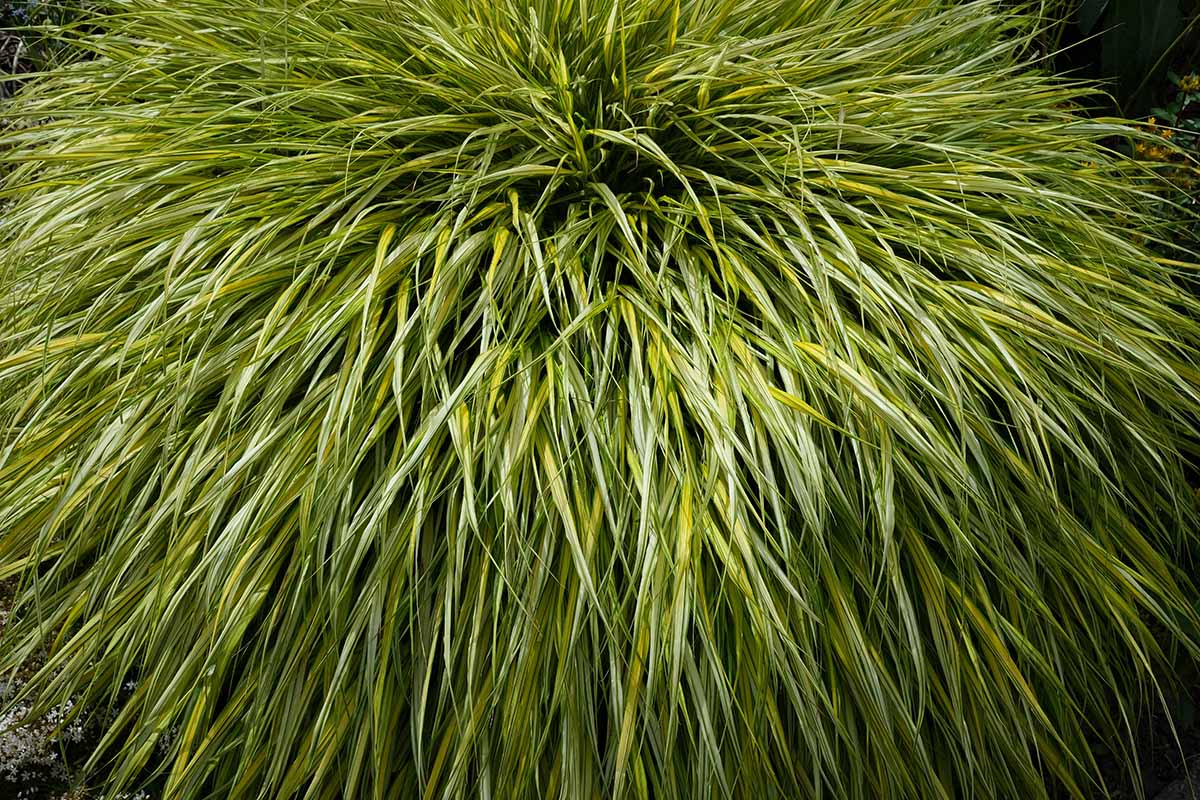
Plus, they send up seed heads that can persist through summer and fall. So much all from one seemingly humble plant.
While any of the green options would be a fantastic choice, imagine how cool the orange fall leaves of New Zealand sedge (C. testacea) would look against the green of your plants.
Depending on the variety, sedges can be just a few inches tall or they might grow up to five feet. Let the specific size and light requirements dictate where you place the plants. They might work as a carpet underneath or as a companion in clumps next to the camellias.
Learn more about how to grow sedge in our guide.
34. Snowdrop
I can’t be the only one whose heart lifts when snowdrops (Galanthus spp.) start peeking out of the ground in late winter or early spring. They’re such a cheerful harbinger of the coming sunshine and warmth.
Hardy in Zones 3 to 8, they do best in full sun but can tolerate a little shade. Just don’t plant them deep underneath your shrubs. They need some sun to reach their full 10-inch height.
Go with the classic and pick up giant snowdrop (G. elwesii) bulbs at Burpee.
Learn how to grow snowdrops in our guide.
35. Tulip
Tulips (Tulipa spp.) are instantly recognizable. Pretty much everyone can identify the colorful blossoms, which herald the coming of spring in Zones 3 to 7.
While they won’t bloom in shady locations, they are perfectly happy in full to partial sun, so they make a nice addition to the southern side of your shrubs.
Depending on the type of tulip and the camellia you’re growing, flowering might overlap a little or the tulips might start blooming after the camellias are done.
For example, ‘Lorenzo’ starts flowering right around Easter and lasts for weeks with its orange, green, and red variegated blooms.
Snag yourself some bulbs at Burpee.
Check out our guide to growing tulips to learn more.
36. Vine Maple
Vine maples (Acer circinatum) are underappreciated. While they can grow up to 30 feet tall and wide in full sun, they can grow in shade as well.
When they do, they stay much smaller and take on a graceful arching, sprawling growth habit that adds an architectural element to the garden.
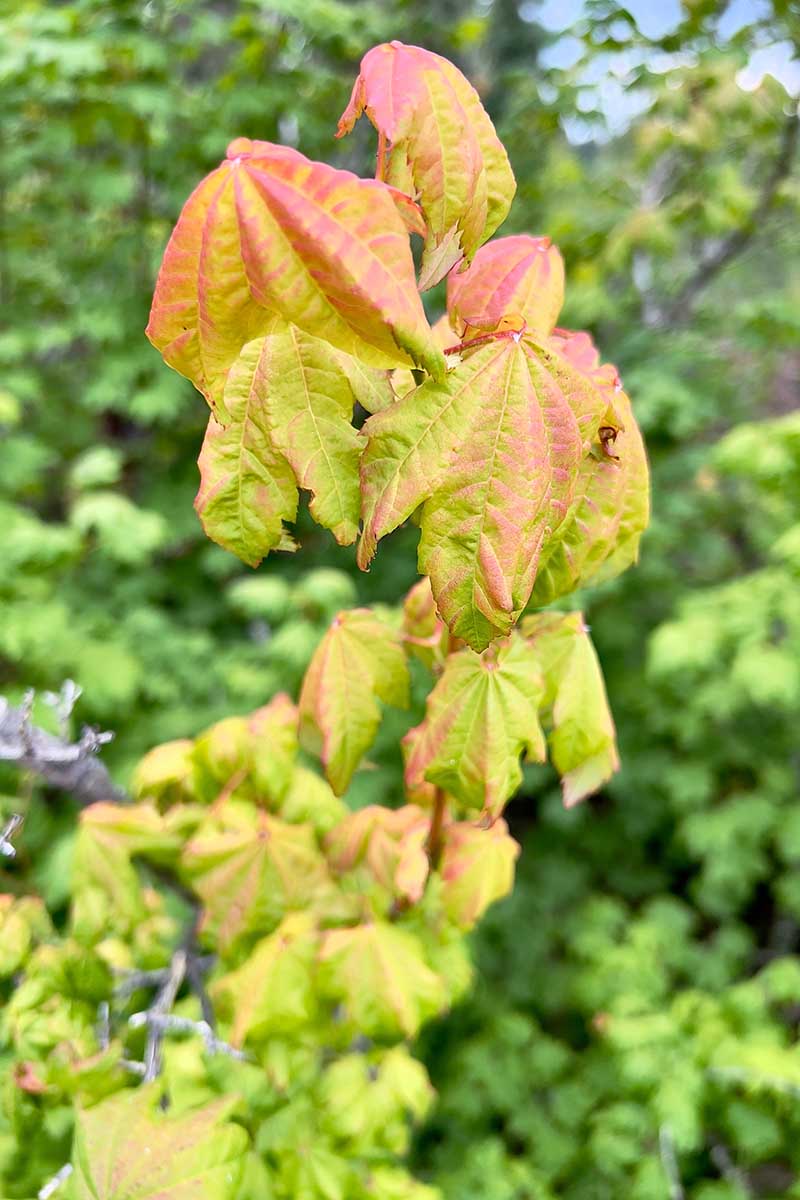
While they’re technically classified as trees, they can also be shrub-like.
I have one growing in front of some camellia shrubs and when it’s in leaf, it adds a lovely lime green hue and textural contrast to the bushes behind it.
When fall arrives, the big red leaves draw all the attention against the green background. Then, in the winter when it’s bare, the slender branches draw the eye back to the star of the winter show.
It’s an unexpected combination that works so well together since the shrubs have similar growing requirements. Vine maples are hardy in Zones 6 to 9.
37. Winter Daphne
A lot of the plants on this list bloom when camellias aren’t flowering.
While it’s nice to have something to pick up the slack and provide some color, it’s marvelous to have a plant that blooms at the same time.
You’ll be absolutely spoiled for color if you pair your camellias with winter daphne (Daphne odora).
Suitable for Zones 7 to 9, the heavily fragrant flowers emerge on the four-foot-tall plant as early as January and provide a heady scent that camellias lack.
This plant likes afternoon shade, so it’s perfect as a companion on the east side of a camellia. They do well in similar conditions, with well-draining, slightly acidic soil.
Marianni® aka ‘Rogbret’ is heat tolerant, with pinkish-purple blossoms and leaves lined in a creamy yellow hue.
If this sounds appealing and you want to bring this cultivar home, visit Nature Hills Nursery.
You can learn more about winter daphne in our guide.
38. Winter Heather
Winter heather (Erica spp.) is actually a heath, but it doesn’t matter what we call it. The dense, evergreen shrubs are adaptable, dependable, and beautiful.
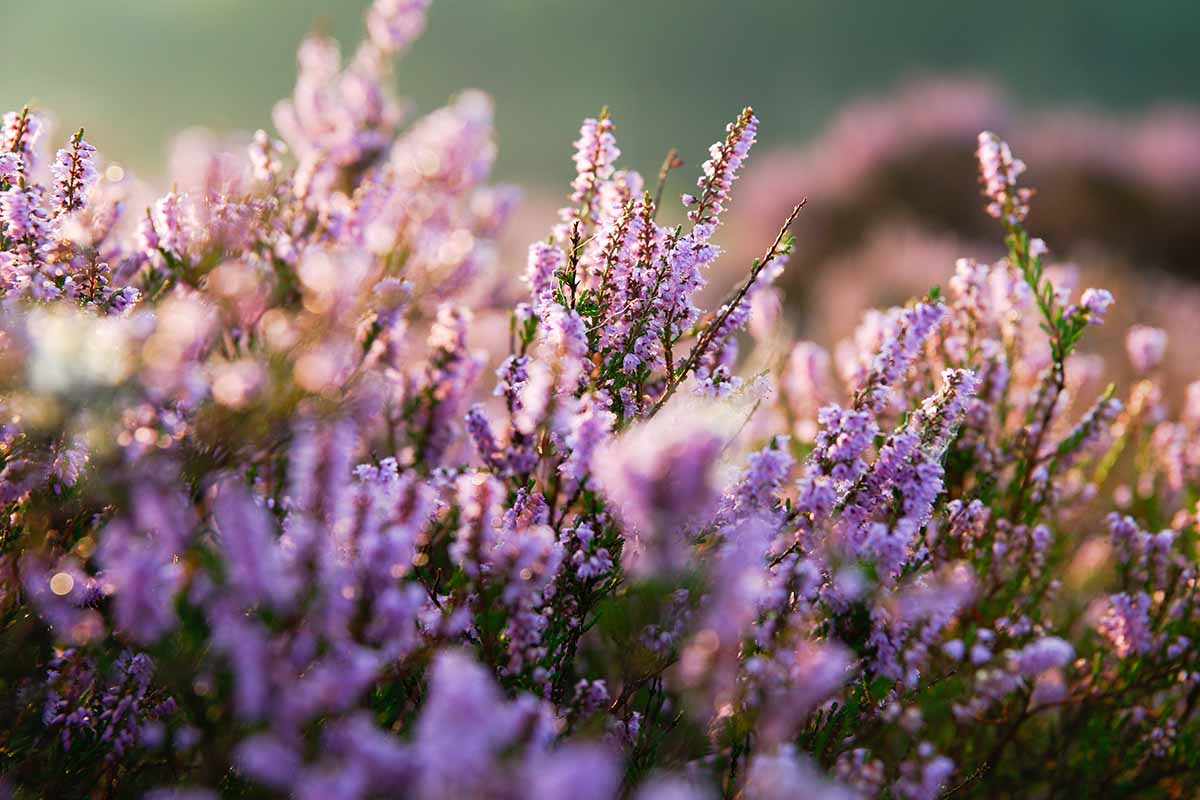
Hardy in Zones 3 to 7, they bloom in the winter, adding a carpet of color. Plant the 10-inch tall plants just under your camellias where they’ll still receive at least a few hours of sun.
Don’t let your heather get too shaded, though. They bloom best when they’re planted in full sun, though they tolerate partial sun.
Winter heather is easy to grow and you can learn how in our guide.
39. Wood Anemone
Pronouncing the name might be a bit of a tongue twister (or is that just for me?), but wood anemones (Anemonoides nemorosa and A. quinquefolia) are worth the potential embarrassment.
These early spring bloomers emerge from the soil with their sunny yellow and white faces, announcing that spring has sprung.
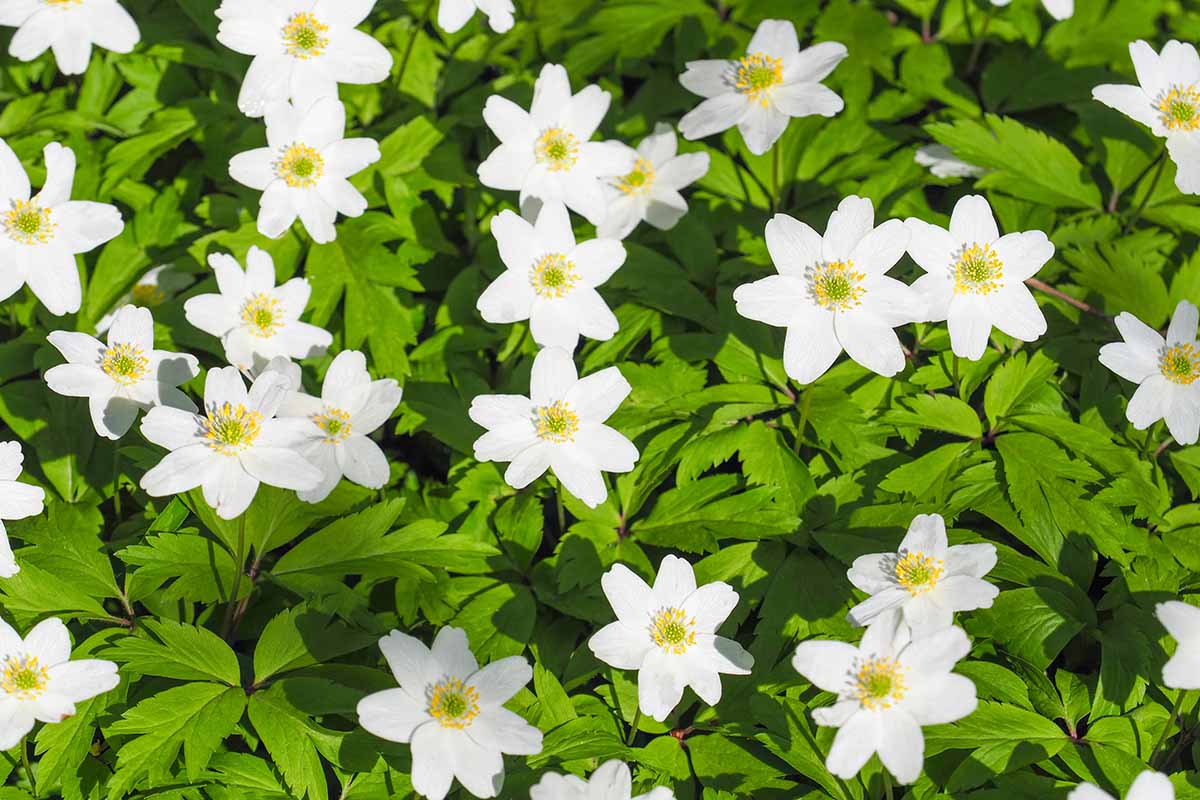
They need dappled shade in Zones 3 to 9 to be happy, so it’s like they were made to help extend the bloom season of camellias by providing a carpet of color underneath and around the shrubs.
Since they rarely grow taller than seven or eight inches, wood anemones make a perfect understory plant.
Visit our guide to learn all about growing wood anemones.
Everything is Better With Friends
A camellia bush in full bloom doesn’t need anything else to make it look incredible, but finding the right companions can amplify the show.
Plus, these plants spend a lot of time wearing nothing but their plain green leaves, so if you can add something to your garden to liven things up, why not?
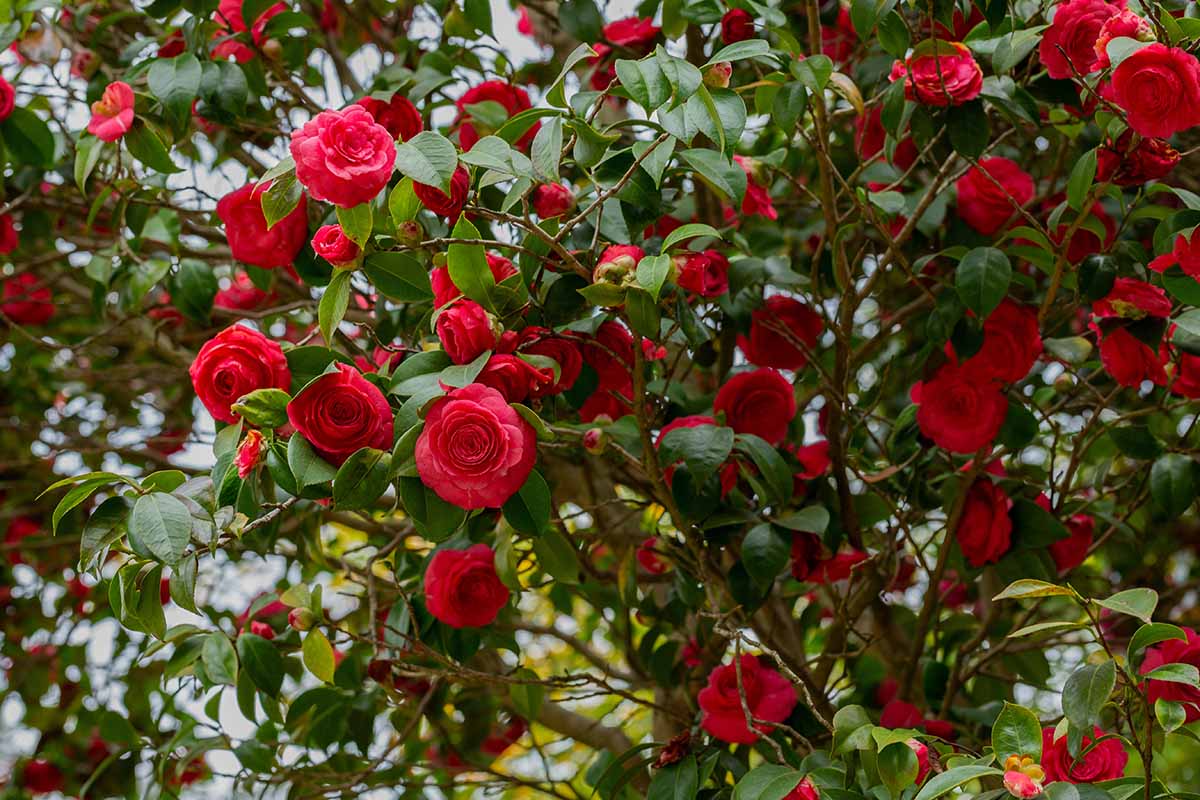
Which of these plants is calling your name? How will you use them as companions in your garden? Share in the comments section below!
Now that they have friends, you might want to learn a bit more about caring for your glorious camellias. If so, we have a few guides you might want to take a look at:
